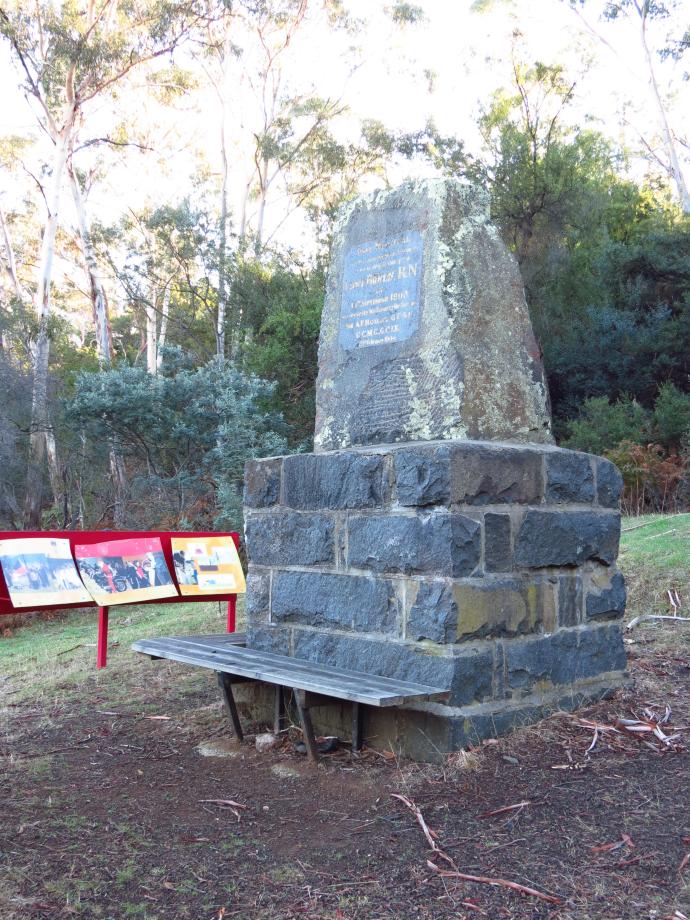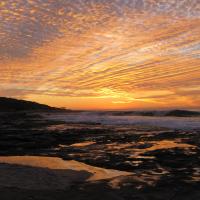Another perfect day, the sun was shining the air was crisp and clear. I felt like exploring, but with no car the alternative was to use the local buses.
So armed with information from the Metro Shop, timetables and of course my camera I sallied forth.
Seven Mile Beach sounds interesting. It is a half hour drive, out through the suburbs and into the country. I am the only passenger on the bus and enjoy the front seat view and chatting to the driver/chauffeur. As a child he lived in this area and told me some interesting details.
The bus would be back in an hour, excellent time for a walk along the beach.
It was a beautiful beach to walk along and I found some interesting shells. Notice how dry the hills look. Tasmania is the second driest capital city and at the moment they need rain, but I am pleased it isn’t raining today.
At the end of the beach is an all in one shop/take away/ garage and I stopped for a coffee. Sitting in the sun I watched the locals walking by with their dogs.
Then it was back to Hobart.
Next place I planned to find was Risdon Cove.
This is the historical site of the first landing of Europeans in Tasmania in 1803. It was quite difficult to find out any details about it. Being so important to the settling of Australia I was expecting to find interesting artefacts, monuments and information boards.
I had 45 minutes before the bus left, time for another coffee and a muffin.
This bus was full, I was surprised. Not really sure where the destination was I thought I would stay on till I either saw a monument or arrived at the end of the bus route, assuming a cove would be a dead-end.
Wrong….
When every one else had got off the bus I asked the driver about Risdon Cove.
“Oh I don’t actually go right past, but I can put you off at the round-about and you can walk approximately a kilometre to the site. It’s owned by the Aboriginals now” he said.
Well he put me off at the round-about which was in the middle of no-where and pointed out which road to walk along. I had to hurry to get across 2 lanes of heavy traffic and walked along the side of the road wondering what the drivers rushing by in their insulated world on wheels would make of this old lady wandering along. No one stopped to ask.
The road wound around a valley with bush clad slopes on either side. I couldn’t see very far ahead. Should I keep going or turn back? Would I see anything when I got there? I almost gave up, then I spotted a sign with a very prominent Aboriginal flag displayed. YES, I had arrived, but arrived at what? A building with children at play, another building that looked like a meeting hall. No sign of a museum and information centre I had read about in an old Lonely Planet book. Then I noticed the signs, they all told of the Aboriginal side of the “invasion” of the white man. There is two sides to every story and the Aboriginals were massacred in Tasmania and deserve recognition. But also the settlers should have acknowledgment at such a historical site.
I followed the track past a beautiful stream, the herons and ducks stalked the fish and the reflections created a tranquil atmosphere. Over a bridge. the monument to John Bowen who landed here with a group of convicts and soldiers in 1803 is surrounded by posters of Aboriginal protests and the handing over of the land in 1995. The historic landing-place is covered in weeds and deteriorating. I walked up the hill to the place the first house was built and could only see a portion of the foundations and a few bricks strewn around.
It was an interesting experience. I was on my own in this historic place and I could feel and visualize the past. The strangeness for both cultures of the other parties. Even today with the sound of the traffic roaring by on the road below it has a feeling of remoteness. The views across the Derwent river where Hobart now stands, in 1803 would be bush and gum trees.
This is a controversial place and I walked back along the road to catch the bus with very mixed feelings. To me this place even with all its neglect and desolation was beautiful, it had a spiritual aura. The large number of water birds in the unpolluted stream, the reflections of the trees giving a feeling of peace. It touched me more than the pristine museums with the exhibits laid out under glass and carefully labelled.
It was an interesting day and the best part? It only cost me $3-20 for my concession day pass and the price of 2 coffees and a muffin. That is budget travelling.
I checked it out on Google, the history is certainly controversial. You can read a version of it here






























